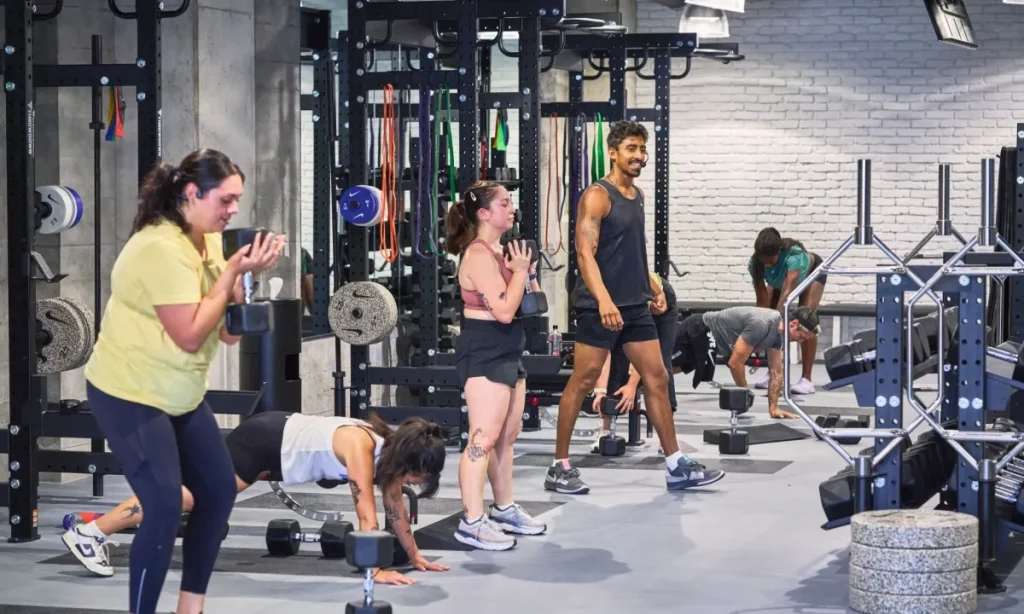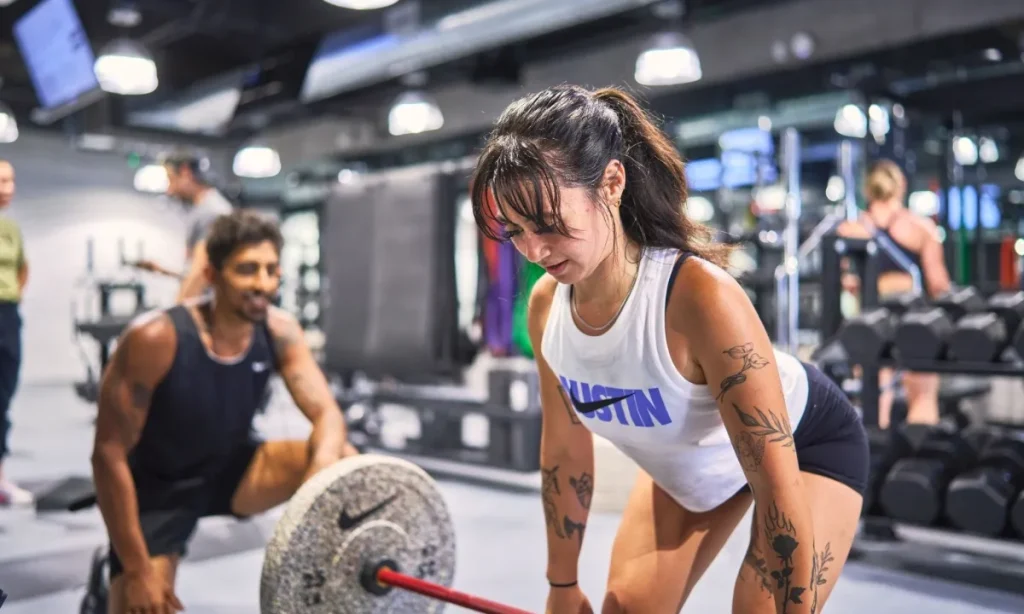
¿Has oído a la gente hablar de WODs, burpees y el "box"? Quizá te preguntes: "¿Qué es el CrossFit?". En términos simples, CrossFit es un programa de fitness que combina diferentes tipos de ejercicio para hacerte más fuerte, más rápido y más en forma en muchos aspectos. Está diseñado para mejorar tu capacidad física en general, no sólo en un área.
Los entrenamientos de CrossFit se basan en movimientos funcionales constantemente variados realizados a alta intensidad. Vamos a desglosarlo:
- Movimientos funcionales: Se trata de ejercicios que imitan las actividades cotidianas que realizas fuera del gimnasio, como sentadillas, levantar peso, empujar, tirar y correr. Piensa en movimientos que te ayuden a llevar la compra, levantar a un niño o subir escaleras con más facilidad.
- Alta intensidad: Esto significa que trabajarás duro. Los entrenamientos están diseñados para ponerte a prueba y aumentar tu ritmo cardíaco para mejorar tu forma física de forma rápida y eficaz.
- Constantemente variada: Rara vez haces el mismo entrenamiento dos veces seguidas. Esto mantiene el interés, desafía a tu cuerpo de diferentes maneras y evita que te estanques en el entrenamiento.
El objetivo del CrossFit es desarrollar una forma física amplia, general e integradora. Pretende mejorar su capacidad en diez dominios reconocidos de la aptitud física: Resistencia Cardiovascular/Respiratoria, Resistencia, FuerzaFlexibilidad, potencia, velocidad, coordinación, agilidad, equilibrio y precisión.
¿Qué ocurre en una clase de CrossFit?
Un gimnasio CrossFit típico, a menudo llamado "box", ofrece clases en grupo dirigidas por entrenadores titulados. Estas clases suelen durar alrededor de una hora y siguen una estructura general:
- Calentamiento: La clase comienza con un calentamiento dinámico para preparar el cuerpo para los movimientos futuros y ayudar a prevenir lesiones. Puede incluir ejercicios cardiovasculares ligeros, estiramientos y ejercicios de movilidad.
- Trabajo de habilidad o fuerza: A continuación, el entrenador se centrará en la práctica de una habilidad específica (como el doble salto con cuerda o un movimiento de gimnasia) o en el desarrollo de la fuerza con un levantamiento específico (como sentadillas o peso muerto). Esta parte te ayuda a mejorar la técnica y a desarrollar la fuerza bruta.
- Entrenamiento del día (WOD): Esta es la parte principal de la clase y donde entra en juego la alta intensidad. El WOD es diferente cada día y puede incluir combinaciones de movimientos funcionales. Los WOD suelen tener nombres (como "Fran" o "Murph") o se describen por su estructura (como AMRAP - As Many Rounds As Possible, o For Time - completar el trabajo lo más rápido posible).
- Enfriamiento/Movilidad: La clase suele terminar con un periodo de enfriamiento, que incluye estiramientos o el uso de herramientas de movilidad para ayudar a los músculos a recuperarse.
Los entrenadores de un gimnasio CrossFit están capacitados para ofrecer modificaciones para todos los niveles de forma física. Por lo tanto, tanto si eres un principiante como un atleta experimentado, el entrenamiento puede ajustarse a tu capacidad. El ambiente de grupo también proporciona un fuerte sentido de comunidad y apoyo, que es una gran parte de lo que hace CrossFit popular.

¿Qué equipo se utiliza en CrossFit?
Un gimnasio CrossFit utiliza una variedad de equipos CrossFit para apoyar sus diversos entrenamientos. No encontrará filas de máquinas de cardio típicas o máquinas de pesas de aislamiento como en un gimnasio tradicional. En su lugar, la atención se centra en herramientas versátiles que permiten movimientos funcionales. El equipo común de CrossFit incluye:
- Pesas y platos: Esenciales para ejercicios de fuerza como sentadillas, peso muerto, press y levantamientos olímpicos (arrancada y levantamiento de peso). Verás varios tipos de placas de peso, incluidas las placas de parachoques diseñadas para dejarse caer con seguridad.
- Aparejos y bastidores: Son la columna vertebral de muchos gimnasios CrossFit. Son grandes estructuras de acero que proporcionan estaciones para pull-ups, muscle-ups, sentadillas y otros ejercicios. Esto incluye:
- Bastidores (o jaulas) de energía: Ofrece un recinto seguro para el levantamiento de pesas con barras de seguridad ajustables.
- Media estantería: Estructuras más abiertas con copas en J y brazos de seguridad.
- Aparejos autónomos: Las grandes estructuras suelen combinar varias estaciones, como barras de dominadas, soportes para sentadillas y, a veces, barras para monos o cuerdas para trepar.
- Aparejos murales: Estanterías que ahorran espacio y se fijan a la pared.
- Kettlebells: Se utiliza para movimientos dinámicos como balanceos, limpiezas, arrancadas y flexiones turcas, para desarrollar la potencia explosiva y el acondicionamiento físico.
- Mancuernas: Se utiliza para una amplia gama de ejercicios, como prensas, filas, estocadas y movimientos con un solo brazo.
- Balones medicinales: Se utiliza para ejercicios como el wall ball (ponerse en cuclillas y lanzar la pelota contra una pared) y diversos ejercicios de core o lanzamientos.
- Saltar a la comba: En concreto, las cuerdas de velocidad, que se utilizan para ejercicios de acondicionamiento físico exigentes, como el doble salto (la cuerda pasa dos veces por debajo de los pies con un solo salto).
- Anillas de gimnasia: Se cuelga de un soporte o de una estructura elevada y se utiliza para realizar ejercicios con el peso del cuerpo, como flexiones con anillas, elevaciones musculares y remos, para desarrollar la fuerza y la estabilidad de la parte superior del cuerpo.
- Máquinas de remo (Ergs): Proporcionan un entrenamiento cardiovascular de todo el cuerpo.
- Bicicletas de asalto / Air Bikes: Bicicletas con ventilador que ofrecen un desafiante entrenamiento cardiovascular de alta intensidad.
- Plyo Boxes: Se utiliza para saltos de caja y otros ejercicios pliométricos para desarrollar la potencia explosiva de las piernas.
- Cuerdas de escalada: Algunos gimnasios tienen cuerdas para escalar, una exigente prueba de fuerza y agarre de la parte superior del cuerpo.
- Otros accesorios: Tizas para el agarre, bandas de resistencia, colchonetas para abdominales, cinturones especializados o envolturas para levantar peso, y mucho más.
La combinación adecuada y la calidad del equipamiento de CrossFit son importantes para un buen box, ya que permiten la variedad e intensidad de la programación.

¿Cuánto cuesta el CrossFit?
El coste de la suscripción a un gimnasio CrossFit en Estados Unidos puede variar bastante en función de varios factores. Por lo general, es más caro que una suscripción a un gimnasio globo estándar debido al menor tamaño de las clases, el entrenamiento especializado y el equipamiento utilizado.
Por término medio, se puede esperar pagar de De $100 a $250+ al mes para ser miembro de CrossFit.
Esto es lo que influye en el precio:
- Ubicación: Los gimnasios de las grandes ciudades o las zonas con un coste de la vida más elevado suelen cobrar más.
- Tipo de afiliación: La mayoría de las cajas ofrecen distintos planes. Las afiliaciones ilimitadas (que permiten asistir a cualquier clase) suelen ser las más caras. Las afiliaciones limitadas (por ejemplo, 2 o 3 clases a la semana) son más baratas.
- Instalaciones y equipos: Los gimnasios con espacios más grandes, equipos de CrossFit más amplios o nuevos y servicios adicionales como duchas o vestuarios pueden tener tarifas más elevadas.
- Cuerpo técnico: Los entrenadores altamente experimentados o certificados también pueden contribuir al coste de afiliación.
- Periodo de compromiso: Algunos gimnasios ofrecen descuentos si te comprometes a un periodo de afiliación más largo (por ejemplo, 3, 6 o 12 meses).
- Programas introductorios: Muchos boxes exigen a los nuevos socios que completen un curso fundamental para aprender los movimientos básicos con seguridad. Estas clases introductorias suelen tener un coste adicional, que puede oscilar entre $100 y $200.
- Tarifas sin cita previa: Si sólo está de visita o quiere probar una clase suelta, suele haber tarifas de inscripción, que suelen costar entre $20 y $30 por sesión.
Aunque el coste inicial puede parecer más elevado, muchas personas encuentran el valor en el entrenamiento, la comunidad y la eficacia de los ejercicios.
Cómo encontrar un gimnasio de CrossFit de calidad en EE.UU.
Encontrar el gimnasio de CrossFit adecuado es importante para disfrutar de una experiencia positiva. En lugar de recomendar gimnasios específicos (ya que la mejor opción depende de tu ubicación y preferencias), aquí tienes algunos consejos sobre cómo encontrar un gimnasio de CrossFit de calidad en Estados Unidos:
- Utiliza el sitio web oficial de CrossFit: En CrossFit.com tiene una herramienta para encontrar gimnasios en la que puedes buscar afiliados oficiales por ubicación. Este es el mejor lugar para empezar a encontrar gimnasios CrossFit legítimos.
- Busque entrenadores certificados: Busque gimnasios donde los entrenadores tengan sus Certificación CrossFit Nivel 1 (CF-L1) como mínimo. Las certificaciones de nivel superior o la experiencia adicional como entrenador también pueden ser indicadores de una instrucción de calidad.
- Visite las instalaciones: Si es posible, visite el gimnasio de CrossFit en persona. Comprueba si el espacio está limpio, bien organizado y cuenta con la Equipamiento CrossFit que cabría esperar.
- Observa o prueba una clase: Muchos gimnasios ofrecen una clase de prueba gratuita o una sesión "introductoria sin sudor" en la que puedes conocer a los entrenadores y ver el ambiente. Es una buena forma de ver si el estilo de entrenamiento y el ambiente de la clase son adecuados para ti.
- Hable con los diputados: Si puede, hable con los miembros actuales sobre sus experiencias. Una comunidad fuerte y solidaria es el sello distintivo de muchos grandes gimnasios de CrossFit.
- Leer reseñas en línea: Consulta las reseñas en plataformas como Google, Yelp o las páginas de las redes sociales del gimnasio para hacerte una idea de las experiencias de otras personas.
- Considere la programación: Pregunta por la filosofía de programación del gimnasio. ¿Se ajusta a tus objetivos? ¿Se hace hincapié en la seguridad y en una técnica adecuada?
Algunos ejemplos de gimnasios CrossFit bien considerados que se han mencionado en varias comunidades de fitness de EE.UU. incluyen CrossFit NYC (Ciudad de Nueva York), CrossFit Una Nación (Boston), y varios gimnasios que envían constantemente atletas a los Juegos CrossFit, aunque los "boxes" locales pueden ser igual de excelentes y más convenientes para usted.
Un repaso rápido
¿Qué es el CrossFit? Es un programa de fitness dinámico basado en movimientos funcionales constantemente variados realizados a alta intensidad. Ofrece un enfoque integral del fitness, con el objetivo de mejorar una amplia gama de capacidades físicas. Con sus entrenamientos variados, el uso de equipos funcionales CrossFit, y un fuerte aspecto comunitario, proporciona una manera desafiante y gratificante para ponerse en forma. Aunque el coste puede variar, el valor del entrenamiento y los resultados es a menudo significativo para los miembros. Si estás buscando una comunidad de fitness que te ofrezca retos y apoyo, encontrar un gimnasio CrossFit de calidad cerca de ti puede ser el siguiente paso perfecto en tu viaje hacia el fitness.
